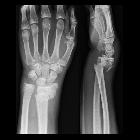chauffeur fracture














Chauffeur fractures (also known as Hutchinson fractures or backfire fractures) are intra-articular fractures of the radial styloid process. The radial styloid is within the fracture fragment, although the fragment can vary markedly in size.
Pathology
Mechanism
These injuries are sustained either from direct trauma typically a blow to the back of the wrist or from forced dorsiflexion and abduction.
The former accounts for its name; trying to start an old-fashioned car with a hand crank sometimes resulted in the crank rapidly spinning backward (backfire) out of the driver's grasp and striking the back of the wrist .
The latter occurs as the scaphoid forcibly impacts upon the radial styloid and can be considered an avulsion fracture with the radiocarpal ligaments remaining attached to the radial styloid .
Radiographic features
Plain films usually suffice in the assessment of chauffeur fractures. Along with other distal radial fractures, the AP film can also be used to classify these fractures according to the Frykman classification of distal radial fractures. Chauffeur fractures are considered type III fractures.
Plain radiograph
The fracture extends proximally in a variable oblique direction (from essentially transverse to almost sagittal) from the distal radial articular surface through the lateral cortex of the distal radius, thus separating the radial styloid from the rest of the radius . Although often the fracture is undisplaced , depending on how sagittal the fracture orientation is, variable proximal migration of the fracture occurs, with an articular step which comes into contact with the scaphoid .
A number of associated injuries are frequently encountered and may significantly impact on management:
- scapholunate dissociation: this is especially true when the fracture line involves the articular surface near the scapholunate interval
- trans-scaphoid perilunate dislocation
- ulnar styloid fracture: equates to a Frykman type IV fracture
Treatment and prognosis
Although these fractures are often undisplaced, they are relatively unstable and often benefit from percutaneous lag-screw fixation .
History and etymology
It was originally named by British surgeon Jonathan Hutchinson (1828-1913). Its other names derive from the typical occupation of people who sustained this injury due to direct trauma from starting a car with a crank. It is also known as backfire fracture or lorry driver fracture .
It is interesting to note that the word chauffeur comes from the French for "someone who warms" the car engine.
Practical points
In addition to reporting the presence of the fracture a number of features should be sought and in many instances commented upon as relevant negatives:
- fracture
- direction: transverse/oblique/sagittal
- where along the articular surface it begins (especially relative to the scapholunate interval)
- displacement and articular step-off and the gap distance
- any comminution
- associated injuries
- scapholunate joint space
- scaphoid fracture
- carpal alignment (especially perilunate)
- ulnar styloid fracture
See also
Siehe auch:
- Colles-Fraktur
- Galeazzi-Fraktur
- Frakturen mit Eigennamen
- Monteggia-Fraktur
- frykman classification of distal radial fractures
- Barton Fraktur
- perilunäre Luxation
- Scapholunäre Dissoziation
- distale Radiusfraktur
- Smith-Fraktur
- Essex-Lopresti fracture
- Frakturen der oberen Extremitäten
- reverse Barton fracture
- Luxationsfrakturen von Radius und Ulna
- Frykman type IV
und weiter:

 Assoziationen und Differentialdiagnosen zu Chauffeur-Fraktur:
Assoziationen und Differentialdiagnosen zu Chauffeur-Fraktur:










